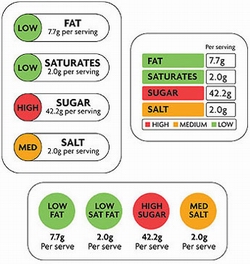
Food Safety Focus (49th Issue, August 2010) – Food Safety Platform
More about Nutrition Label
Reported by Ms. Melissa LIU, Scientific Officer,
Risk Assessment Section, Centre for Food Safety
In the last issue, we have learnt that nutrition claims are useful in making quick reference when choosing foods. However, other information on nutrition label is also important in making your healthier food choices.
Knowing the Full Picture
Are all foods with eye-catching nutrition claims of low fats, low sugars or low sodium are really healthier?
The simple answer is "not necessarily". Some products with claims such as "low fat" could be high in sodium or sugars, not as healthy as we have thought. Some products may not choose to use nutrition claims even through they have met relevant specified conditions. Therefore, besides the nutrition claims, it is wise also to read the nutrition label which gives a more comprehensive picture of the product before making our choices.
More Tools for Easier Choice
In fact, it requires time and knowledge to choose food by reading though the whole nutrition label for the overall nutrient contents of products. Therefore, in recent years, many attempts have been made to facilitate consumers to choose healthier foods.
Percentage Nutrient Reference Values
Nutrient Reference Values (NRV) are a set of figures developed for use in nutrition labelling system. Percentage values (%NRV) are to illustrate the product's nutrient amounts in relation to the NRV. In Hong Kong, apart from the mandatory declaration of absolute values of energy and nutrients on nutrition labels, energy and nutrient values may further be expressed as the ratio (as a percentage ) of the values to the NRV listed in the law. Considering the nature of Hong Kong's food supply, the trade is also allowed to use NRV adopted by any national or international health authority. By reading the %NRV, consumers may compare the nutrient content in different foods and roughly estimate how the foods fulfill their nutritional needs.
Signposting
Still, labels with %NRV requires the consumers to look at the values for each nutrient. Therefore some countries use signposting to help consumers. The "traffic light labelling" promoted in the United Kingdom is an example. It shows consumers at-a-glance if a food has high, medium or low amounts of the selected nutrients by highlighting their levels in red, amber and green on the front of pack. In the example taking from the UK guidelines as shown, the consumer can quickly understand product with this sign is low in fat and saturated fats (green), high in sugar (red), and with a medium level of sodium content (amber).

Examples of traffic light labels in the United Kingdom (Source: "Front-of-Pack Traffic Light Signpost Labelling Technical Guidance", Issue 2, November 2007, Food Standards Agency, United Kingdom)
Nutrient Profiling
Australia and some European countries have attempted to introduce another idea of "nutrient profiling" to help consumers. In simple terms, a food product is eligible for making nutrition claims provided it fits in a particular nutrient profile or overall nutritional status considered as "healthier". For example, a product may only claim to be "low fat" if its other nutrients, such as sugars and sodium, exist in acceptable amounts. However, this system is complicated and there is still no international consensus on the methods and the application in regulatory control of nutrition claims.
Moving for a Healthier Hong Kong
The implementation of nutrition labelling scheme in Hong Kong provides a supportive environment for development of healthier foods and making healthier choices. Helping the public to make better use of the information is a priority. To this end, we have produced a set of shopping guides taking reference from the %NRV concept and are also developing other types of resource materials for consumers. After all, we hope to enable public to enjoy the variety of food while maintaining a balanced and healthy diet.
 |
|
Shopping guide cards produced by the CFS |


